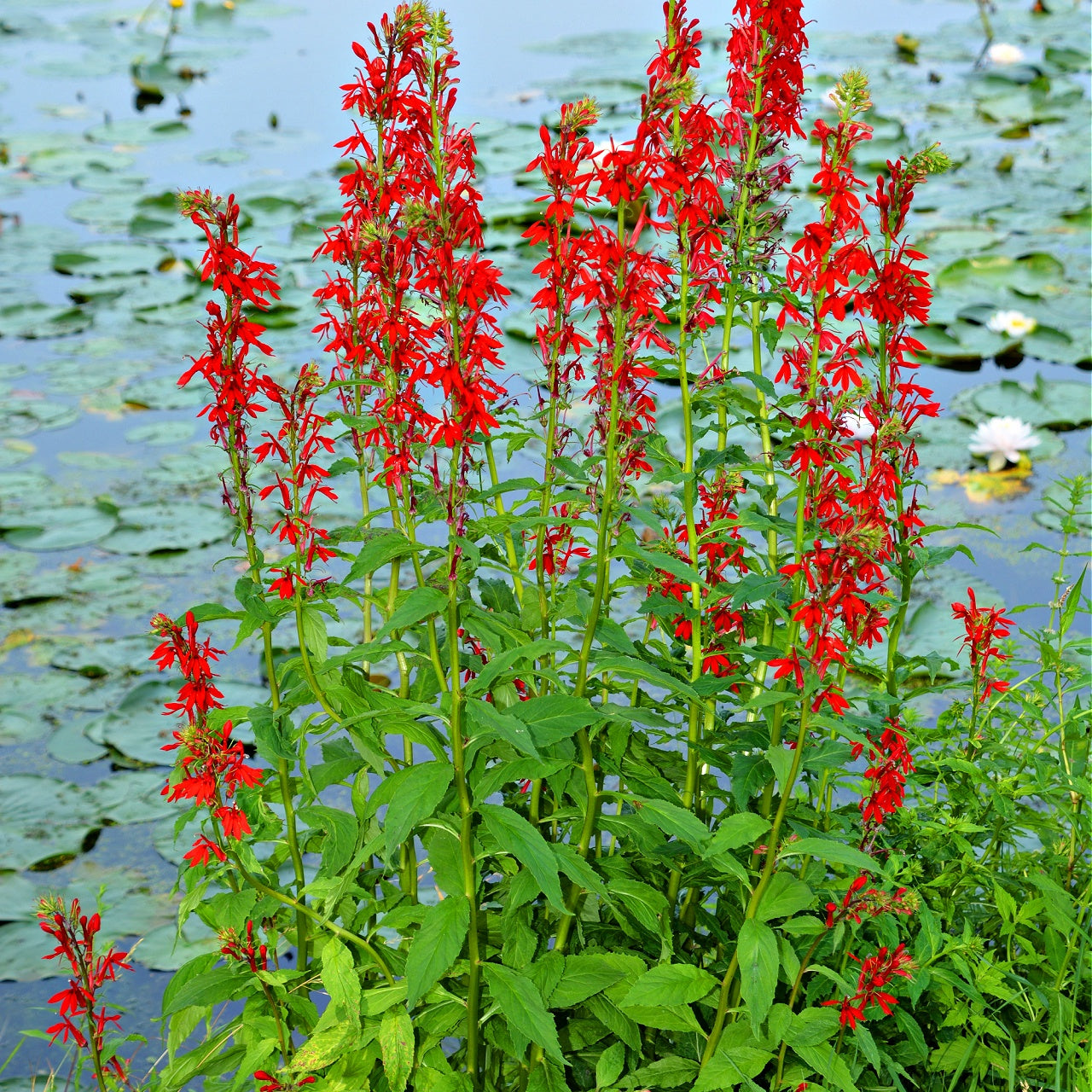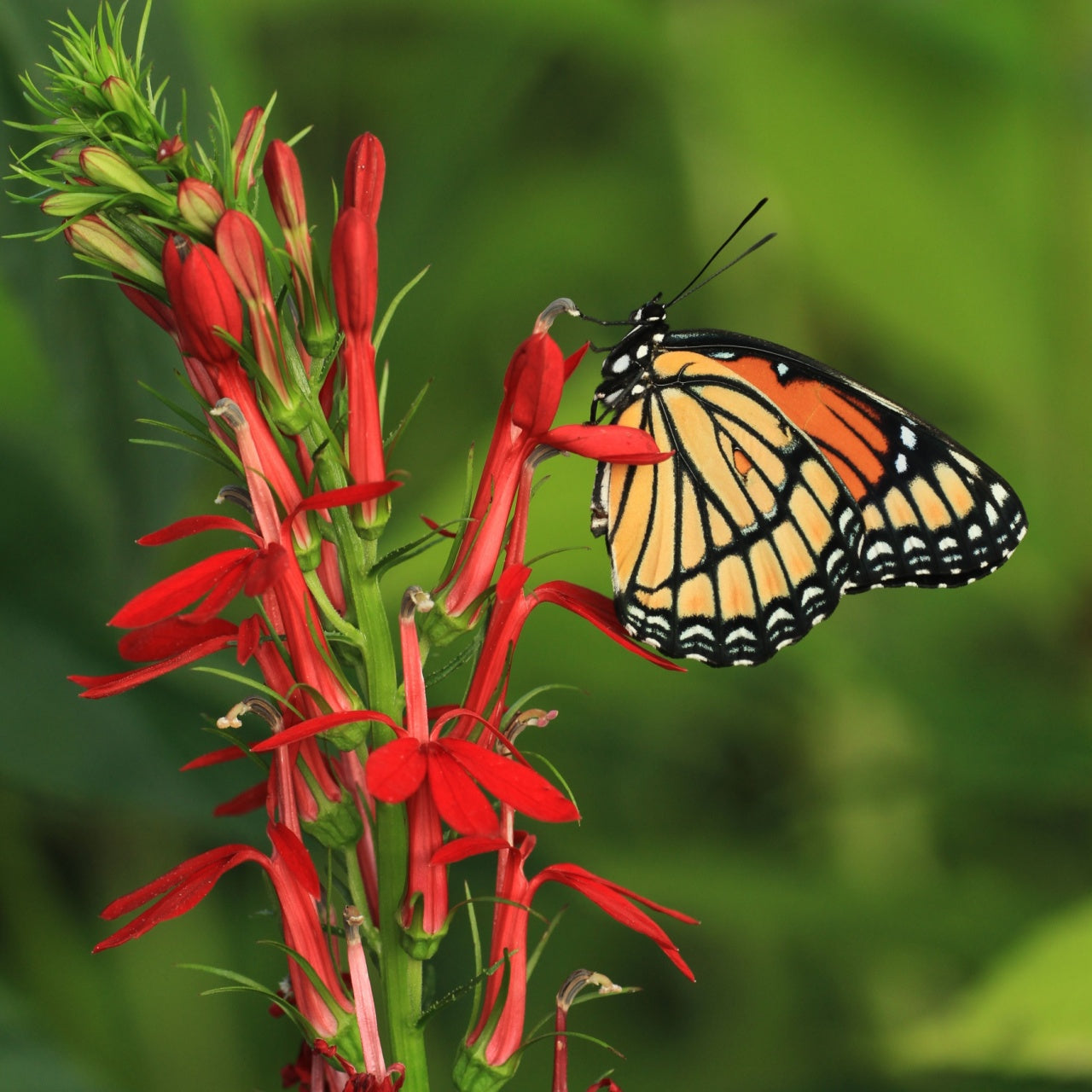Red Lobelia Plants
Red Lobelia Plants
This plant ships:
Ships Week of May 12thCouldn't load pickup availability
Exposure
Sun or ShadeHeight at Maturity
Over 12 InchesUsage
Flower GardensShipped As
Bare-rootShips
Ships Week of May 12thPlanting Zones
3-9Red Lobelia Plants
The Red Lobelia plants will give you vibrant scarlet blossoms to enjoy. They will brighten any flower garden or natural area and grow great in sunlight and lightly shaded areas. It thrives in moist soil and grows well in regular soil. It also attracts lovely tiny hummingbirds, which you can enjoy watching.
Flower Form: Each Flower has three lower and two upper petals that all get pulled together at the base in a tube form. Dark green, lance-shaped leaves line the bottom half of the stem and curl upward from their central veins.
Because of their many colors and aromatic fragrance, they make the perfect addition to open shady border areas, butterfly or hummingbird gardens, ponds or streams, woodland or native gardens, or wild gardens.
Red Lobelia Plants Are Very Eye-Catching
This perennial Flower is grown in botanical gardens. For centuries, it has warranted attention from anyone who has seen it. The early North American settlers immediately recognized its brilliance, and the French colonists first sent it to France to be grown in botanical gardens.
Because of the flower's striking beauty, over-harvesting has resulted in this sensitive type being rarely found in the wild. Growing the flower in the garden preserves its legacy and fulfills an ecological niche.
The Red Perennial Reaches Around 2-3 Feet Tall
This relatively short clump-forming perennial rises between two and three feet tall in terminal spikes. Very infrequently, this flower stands up to four feet tall. It will often spread between 10 and 14 inches. Red Lobelia, the bright scarlet flowers are tubular, with the upper lip having two lobes while the bottom rim has three.
Humming Birds Love This Red flower
Despite its name, It is not attractive to birds but will likely attract hummingbirds and butterflies to your landscaping. They are named after the scarlet robes that Roman Catholic cardinals wear. Expect the flowers to appear in early summer and last through early autumn. After the flowers fade, a blue-green seed pod will look.
It loves to be wet and will tolerate brief periods of flooding. Many mulches around it help the soil retain moisture. This showy Flower prefers full sun in colder climates, while in warmer climates, it prefers some shade during the day's heat.
It prefers to grow in clay soil but will tolerate alkaline or acidic soils. It often makes an excellent backdrop to other types in a natural or rain garden. It also does well in one-gallon or larger containers. The stalks on these are incredibly stocky. The bottom of the stem has lance-shaped leaves on alternating sides.
This perennial is an American wildflower local to the Midwestern region, Michigan, and Wisconsin. Tall spikes of beautiful scarlet, trumpet-formed blooms transcend the dull green foliage. Each Flower has three spreading lower and two upper petals assembled into a tube at the base.
Erect green stems are frequently in groups, with racemes of blossoms that look like flaming scarlet spires. They add beautiful, bright colors to any landscape or floral garden. Their deer and rabbit are resistant yet stunning, with butterflies and hummingbirds.
Developing blossoms sprout amid summer and, in some cases, into fall. Many insects have a hard time following the long necks of the trumpet-formed blooms, so blossoms rely upon hummingbirds for preparation. They also require moist, ripe soil and perform best, considering that organic matter is incorporated into the dirt before planting.
This Flowering Perennial Adds a Beautiful Bright Touch of Color to Any Landscape or Floral Garden
You can transfer the red lobelia plants outside four weeks after you planted them in the fitting plate, picking a zone with full sun or incomplete shade and fertile, loamy, and ideally wet soil. For best results, place a 2-to 3-inch layer of natural mulch around the blossoms and water consistently, keeping the dirt continually sodden for the bloom amid the developing season. It is not dry-season tolerant and performs best with continuously wet soil.
Sun Exposure: Full sun to partial shade
Mature Height: 8-12 inches
Spread: 5-9 inches
Spacing: 6 - 12 inches
Growth Rate: Slow to moderate
Flowering Time: July, August, and September
How Long It Flowers: Perennial
Flower Color: Red, white, or rose
Soil Requirements: Wet, clay, sandy or loamy, mildly alkaline to mildly acidic soil
Pruning: Prune off dying bloom debris as it appears through the fall
Share



i made additional orders of this varieties and getting ready on my space where I plan to plot this out.
Much bigger than expected. These will probably flower this year. Great leaf color and roots. Seem very healthy
I got these and planet on beside my little creek they have thrived and multiplied.
Looks Fantastic by our garden pond.
Plants looked good and were planted within 4 days of receipt.



